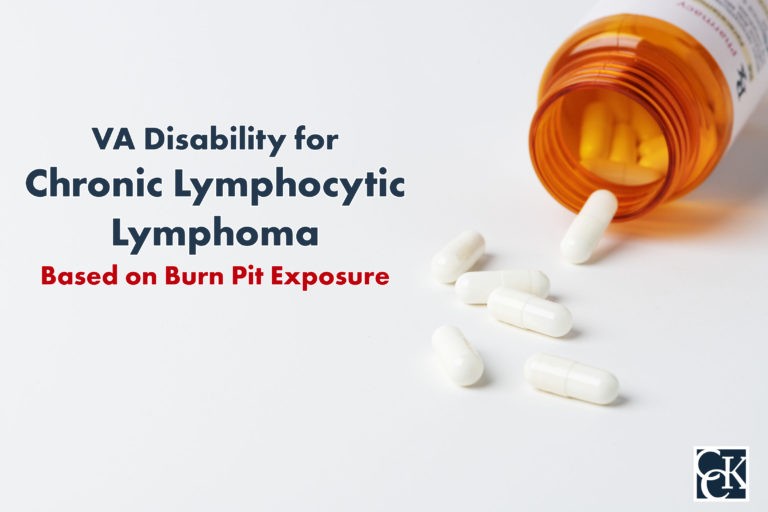VA Disability for Chronic Lymphocytic Lymphoma: Burn Pit Exposure

CCK Law: Our Vital Role in Veterans Law
Chronic lymphocytic leukemia is a form of blood cancer which begins in the bone marrow. The cancer can progress slowly or rapidly, based on what form it takes. There are generally two forms of chronic lymphocytic lymphoma, or CLL. One form is referred as the slower-growing form, while the other is the faster-growing form.
The slower-growing form can remain stable for years and has normal, or slightly below normal, levels of red blood cells, platelets, and neutrophils in the blood, with an increased number of lymphocytes (i.e., white blood cells).
The faster-growing form has an excessive number of CLL cells in the blood which can block normal cell production. As a result of this, the faster-growing form can cause a person to have less fully functioning red cells and platelet levels than normal.
CLL is the most common form of leukemia in adults. People with CLL may be at risk for a number of different conditions as a result of their lowered number of healthy blood cells.
Symptoms of Chronic Lymphocytic Lymphoma
- Exhaustion
- Difficulty breathing, or shortness of breath
- Chills or night sweats
- Risk of infection
- Swollen lymph nodes
- Weight loss
- Pain, or a sense of fullness, in the stomach
Conditions Associated with Chronic Lymphocytic Lymphoma
- Anemia—Anemia is a condition that occurs when a person has a low number of red blood cells. Anemia usually causes fatigue and difficulty breathing, or shortness of breath.
- Neutropenia—Neutropenia occurs when a person has a low number of white cells, which prevent the immune system from guarding against infection effectively
- Thrombocytopenia—This condition occurs when the person has a low number of platelets. This can cause bleeding and bruising.
Compensation and Pension (C&P) Exams for Chronic Lymphocytic Leukemia
If a veteran files a claim for Chronic Lymphocytic Leukemia, VA may request a Compensation and Pension exam, or C&P exam. To request an exam, VA may send the veteran a letter or call them. It is important to follow through with scheduling and attending this exam, otherwise VA could deny the veteran’s claim.
The exam will usually be performed by a VA physician or a VA contracted physician. Before the exam, the examiner will review the veteran’s c-file. This will contain any documentation that has previously been submitted to VA, as well as the veteran’s medical and service records.
The veteran may also use a DBQ, or Disability Benefits Questionnaire, to bolster their claim. A Disability Benefits Questionnaire is a form created by the VA so that the veteran may address important aspects of their condition, such as symptoms, severity, possible causes, and relation to other disabilities. The veteran may also have their private doctor fill out a DBQ for them. In claims for Chronic Lymphocytic Leukemia, DBQs can be helpful because a private doctor which may treat the veteran’s cancer can provide insight into the veteran’s condition.
VA Ratings for Chronic Lymphocytic Leukemia
Chronic Lymphocytic Leukemia is rated under Diagnostic Code 7703 for Leukemia. Unlike other forms of cancers or leukemias, CLL does not have an inactive phase. This means that VA never rates CLL as anemia, aplastic anemia, or on the residuals of the cancer. As such, there is only one rating that can be given for CLL.
- 100%—This rating, for leukemia, is given to veterans with an active leukemia disease or during a treatment phase. While other forms of leukemia may be rated under Diagnostic Code 7700 and Diagnostic Code 7716 for anemia and aplastic anemia, CLL is not because it does not have an inactive phase.
Additionally, the 100 percent rating for CLL continues, even after treatment has ceased.
Burn Pits and Chronic Lymphocytic Leukemia
Veterans who served in the post-9/11 era may have been exposed to toxins through military burn pits. As a result, many veterans have developed chronic lymphocytic leukemia from the exposure they incurred during their service.
What are Military Burn Pits?
Military burn pits are large areas of land where waste was incinerated by the military and its contractors. The United States Military used burn pits as part of its waste disposal protocol in places such as Iraq and Afghanistan in the post-9/11 era. The practice was effective in reducing large quantities of waste, but the pits emitted plumes of toxic smoke. The following materials have been linked to military burn pits:
- Human waste
- Medical waste
- Ammunition
- Paint
- Plastic
- Rubber
- Styrofoam
- Other toxic chemicals
- Spoiled food
- Lubricants
- Petroleum
What Conditions Have Been Linked to Burn Pits?
The Honoring Our Promise to Address Comprehensive Toxics (PACT) Act, established in August 2022, offers needed relief to veterans suffering the toxic effects of burn pit exposure. The following conditions have been linked to burn pit exposure as of the 2022 PACT Act:
- Asthma diagnosed after service
- Head cancer (of any type)
- Neck cancer (of any type)
- Respiratory cancer (of any type)
- Gastrointestinal cancer (of any type)
- Reproductive cancer (of any type)
- Lymphoma cancer (of any type)
- Lymphomatic cancer (of any type)
- Kidney cancer
- Brain cancer
- Melanoma
- Pancreatic cancer
- Chronic bronchitis
- COPD
- Constrictive bronchiolitis or obliterative bronchiolitis
- Emphysema
- Granulomatous disease
- Interstitial lung disease
- Pleuritis
- Pulmonary fibrosis
- Sarcoidosis
- Chronic sinusitis
- Chronic rhinitis
- Glioblastoma
Covered veterans (as defined in the PACT Act) suffering from chronic lymphocytic leukemia are eligible for presumptive service connection.

TDIU and Chronic Lymphocytic Leukemia
Veterans who are prevented from working because of their chronic lymphocytic leukemia may be able to receive a monthly VA disability called total disability based on individual unemployability, or TDIU. This benefit compensates veterans at the 100 percent rating level, even if their disability rating may be less than that.
There are generally two pathways for veterans seeking TDIU:
- 38 CFR § 4.16a (“Schedular”) – For this form of TDIU, the veteran must have:
- One condition rated at minimum 60 percent OR two conditions that can be combined to reach 70 percent, where one condition is at minimum 40 percent
- 38 CFR § 4.16b (“Extraschedular”) – This form of TDIU is for veterans who may not be able to meet the necessary criteria for schedular TDIU, but are still unable to obtain substantially gainful employment on account of their conditions. In this instance, the veteran must prove that their condition hinders their ability to obtain substantially gainful employment and therefore should not be rated based on the standard disability rating criteria.
Getting Assistance with VA Disability Benefits for Chronic Lymphocytic Leukemia
If you need help with your VA disability claim for chronic lymphocytic leukemia, contact the VA disability lawyers at Chisholm Chisholm & Kilpatrick for a free consultation at 800-544-9144.
About the Author
Share this Post

